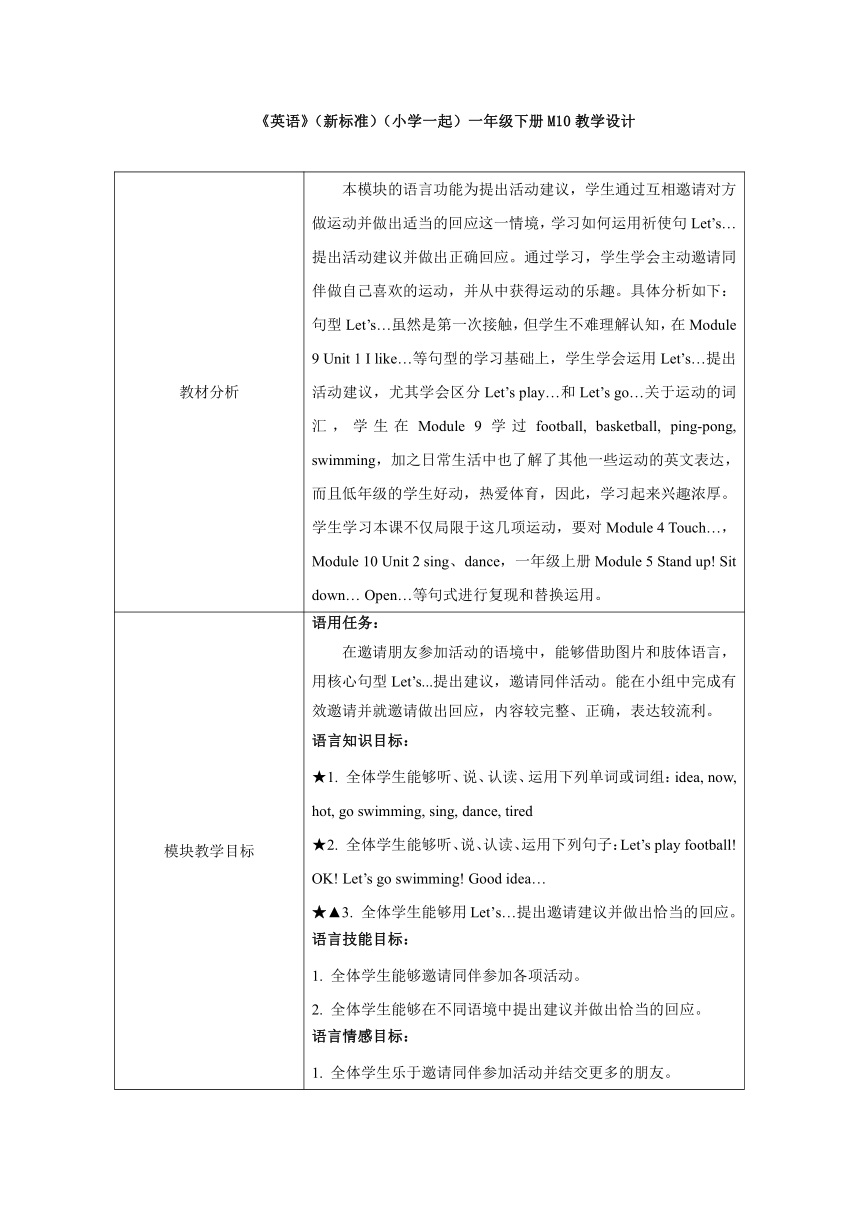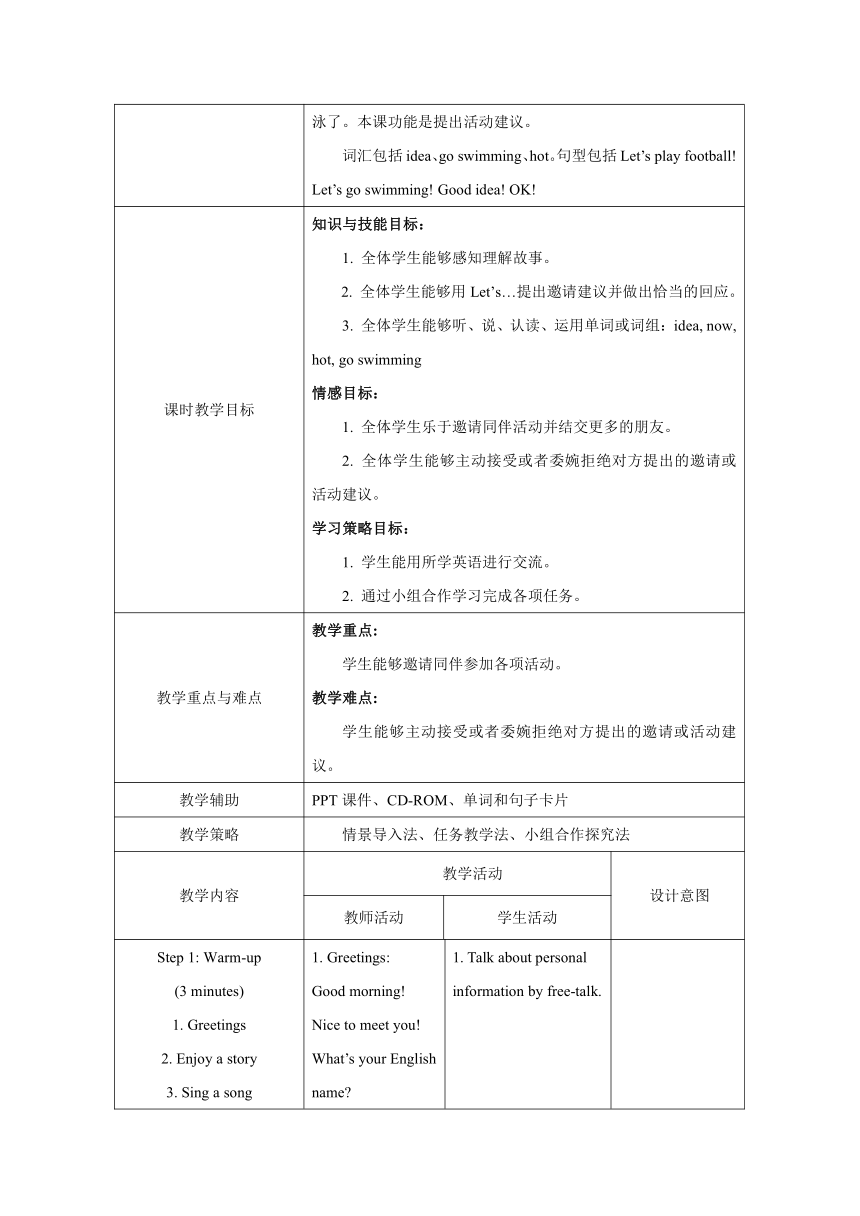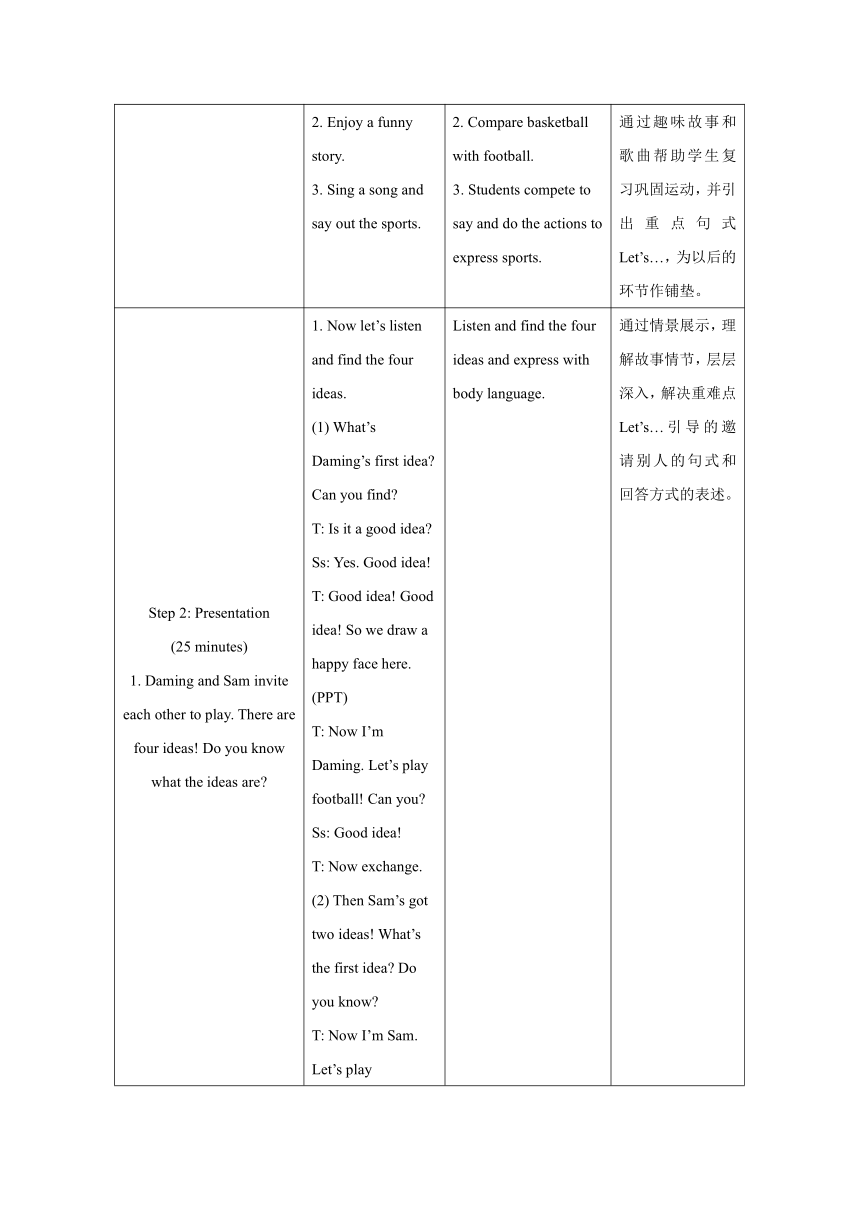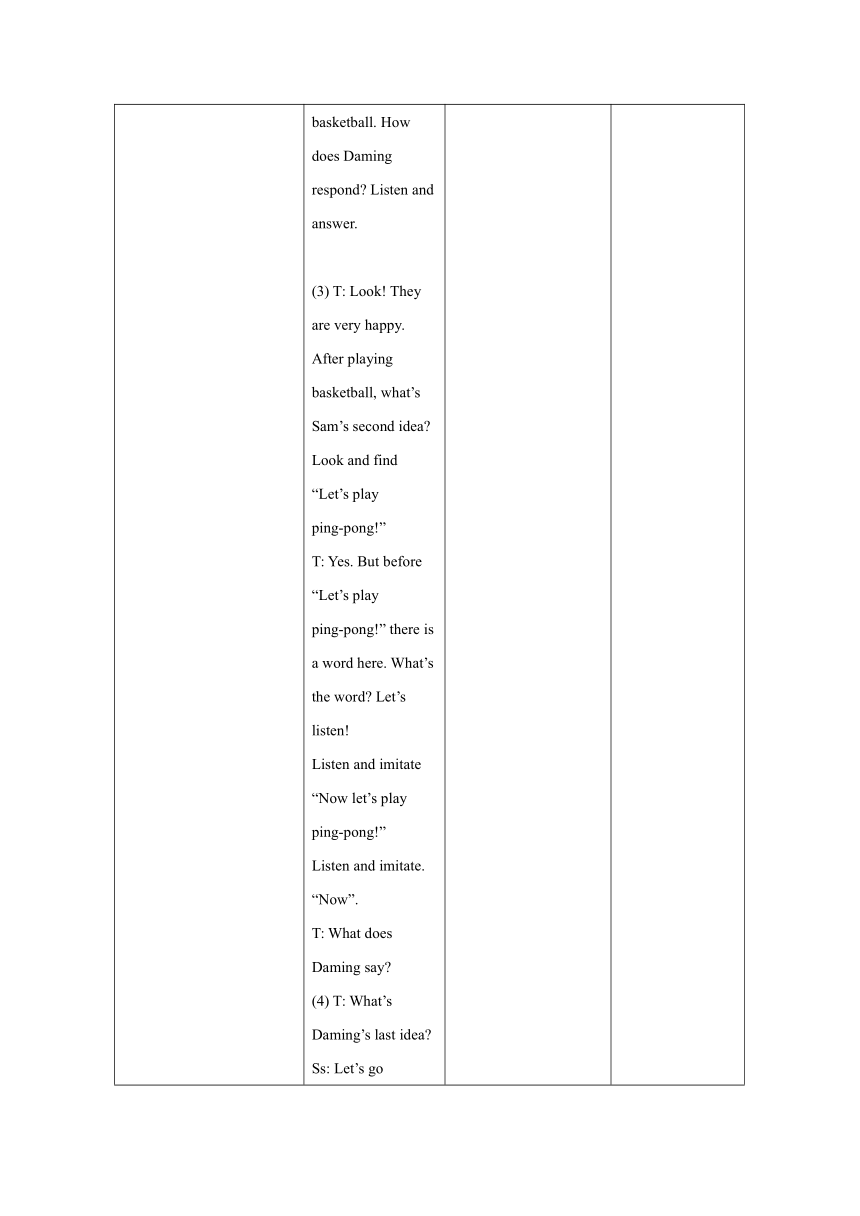小学英语外研版(一年级起点)一年级下册 Module 10 表格式教案(3个课时)
文档属性
| 名称 | 小学英语外研版(一年级起点)一年级下册 Module 10 表格式教案(3个课时) |  | |
| 格式 | docx | ||
| 文件大小 | 65.8KB | ||
| 资源类型 | 教案 | ||
| 版本资源 | 外研版(一年级起点) | ||
| 科目 | 英语 | ||
| 更新时间 | 2022-03-12 22:11:04 | ||
图片预览





文档简介
《英语》(新标准)(小学一起)一年级下册M10教学设计
教材分析 本模块的语言功能为提出活动建议,学生通过互相邀请对方做运动并做出适当的回应这一情境,学习如何运用祈使句Let’s…提出活动建议并做出正确回应。通过学习,学生学会主动邀请同伴做自己喜欢的运动,并从中获得运动的乐趣。具体分析如下:句型Let’s…虽然是第一次接触,但学生不难理解认知,在Module 9 Unit 1 I like…等句型的学习基础上,学生学会运用Let’s…提出活动建议,尤其学会区分Let’s play…和Let’s go…关于运动的词汇,学生在Module 9学过football, basketball, ping-pong, swimming,加之日常生活中也了解了其他一些运动的英文表达,而且低年级的学生好动,热爱体育,因此,学习起来兴趣浓厚。学生学习本课不仅局限于这几项运动,要对Module 4 Touch…,Module 10 Unit 2 sing、dance,一年级上册Module 5 Stand up! Sit down… Open…等句式进行复现和替换运用。
模块教学目标 语用任务: 在邀请朋友参加活动的语境中,能够借助图片和肢体语言,用核心句型Let’s...提出建议,邀请同伴活动。能在小组中完成有效邀请并就邀请做出回应,内容较完整、正确,表达较流利。 语言知识目标: ★1. 全体学生能够听、说、认读、运用下列单词或词组:idea, now, hot, go swimming, sing, dance, tired ★2. 全体学生能够听、说、认读、运用下列句子:Let’s play football! OK! Let’s go swimming! Good idea… ★▲3. 全体学生能够用Let’s…提出邀请建议并做出恰当的回应。 语言技能目标: 1. 全体学生能够邀请同伴参加各项活动。 2. 全体学生能够在不同语境中提出建议并做出恰当的回应。 语言情感目标: 1. 全体学生乐于邀请同伴参加活动并结交更多的朋友。 2. 全体学生能够主动接受或者委婉拒绝对方提出的邀请或活动建议。 学习策略: 1. 任务型学习策略目标:通过完成编韵律歌谣的任务,复习旧知,在真实的情境中运用所学句型:Let’s... No, no, thank you. Good idea!进行真实交流,结交朋友。 2. 运用型学习策略目标:学生通过学唱英语歌谣,巩固重点句型,并与同伴互助自编新歌谣,不断替换运用重点句型;学生能够借助教师提供的运动图片和手势(伸出大拇指、摆手、笑脸等)提出活动建议,并在真实语境中运用。 3. 游戏学习策略目标:通过游戏竞赛抢答,在运动词语与动作之间建立联想,学生认读能力得到提高,达成熟练准确运用Let’s…句型的目标。 文化意识: 知道世界上主要的文娱和体育活动,了解中西方相关活动的传统和特点。
教学重点及难点 教学重点: 学生能够邀请同伴参加各项活动。 学生能够在不同语境中提出建议并做出恰当的回应。 教学难点: 学生能够主动接受或者委婉拒绝对方提出的邀请或活动建议。
教学辅助 PPT课件、CD-ROM、真实的足球或篮球等、单词和句子卡片
教学策略 情景导入法、全身反应法、任务教学法、小组合作探究法
教学过程
第一课时教学设计
教材分析 本课话题围绕Sam和Daming互相邀请对方运动,Daming先邀请Sam踢足球并得到肯定回应,Sam随后分别邀请Daming打篮球和打乒乓球,他们愉快地打完篮球后,Daming感到很热委婉地拒绝了打乒乓球的邀请,最后在Daming的邀请下他们去游泳了。本课功能是提出活动建议。 词汇包括idea、go swimming、hot。句型包括Let’s play football! Let’s go swimming! Good idea! OK!
课时教学目标 知识与技能目标: 1. 全体学生能够感知理解故事。 2. 全体学生能够用Let’s…提出邀请建议并做出恰当的回应。 3. 全体学生能够听、说、认读、运用单词或词组:idea, now, hot, go swimming 情感目标: 1. 全体学生乐于邀请同伴活动并结交更多的朋友。 2. 全体学生能够主动接受或者委婉拒绝对方提出的邀请或活动建议。 学习策略目标: 1. 学生能用所学英语进行交流。 2. 通过小组合作学习完成各项任务。
教学重点与难点 教学重点: 学生能够邀请同伴参加各项活动。 教学难点: 学生能够主动接受或者委婉拒绝对方提出的邀请或活动建议。
教学辅助 PPT课件、CD-ROM、单词和句子卡片
教学策略 情景导入法、任务教学法、小组合作探究法
教学内容 教学活动 设计意图
教师活动 学生活动
Step 1: Warm-up (3 minutes) 1. Greetings 2. Enjoy a story 3. Sing a song 1. Greetings: Good morning! Nice to meet you! What’s your English name 2. Enjoy a funny story. 3. Sing a song and say out the sports. 1. Talk about personal information by free-talk. 2. Compare basketball with football. 3. Students compete to say and do the actions to express sports. 通过趣味故事和歌曲帮助学生复习巩固运动,并引出重点句式Let’s…,为以后的环节作铺垫。
Step 2: Presentation (25 minutes) 1. Daming and Sam invite each other to play. There are four ideas! Do you know what the ideas are 1. Now let’s listen and find the four ideas. (1) What’s Daming’s first idea Can you find T: Is it a good idea Ss: Yes. Good idea! T: Good idea! Good idea! So we draw a happy face here. (PPT) T: Now I’m Daming. Let’s play football! Can you Ss: Good idea! T: Now exchange. (2) Then Sam’s got two ideas! What’s the first idea Do you know T: Now I’m Sam. Let’s play basketball. How does Daming respond Listen and answer. (3) T: Look! They are very happy. After playing basketball, what’s Sam’s second idea Look and find “Let’s play ping-pong!” T: Yes. But before “Let’s play ping-pong!” there is a word here. What’s the word Let’s listen! Listen and imitate “Now let’s play ping-pong!” Listen and imitate. “Now”. T: What does Daming say (4) T: What’s Daming’s last idea Ss: Let’s go swimming. T: How does Sam respond Listen and find the four ideas and express with body language. 通过情景展示,理解故事情节,层层深入,解决重难点 Let’s…引导的邀请别人的句式和回答方式的表述。
2. Paraphrase When we accept the invitation, we can say, “OK! Let’s play or go!” When we decline the invitation, we can say, “No…” T: Now I want to invite you to play. Students stand up and accept the invitations or decline. 复述板书重点句式和回答,并用TPR让学生动起来。在真实情景中感知理解。
3. Chant and make a new chant Let’s chant! Listen. Do you like it T: First, let’s review what we have learnt before. Let’s read! Follow me! T: OK! I’ll make a new one! Let’s enjoy my new chant. Now it’s your turn. Students review what they have learnt before and follow the teacher’s chant. Practice in pairs to make a new chant and show in class. 充分利用歌谣,并进行创作改编,回顾以前所学的词组,对知识进行梳理,解决了难点知识。 发挥了学生的合作精神。
Step 3: Practice (5 minutes) 1. Open your book, turn to P56. Find and circle “Let’s…” (Circle the whole sentence). 2. Do some exercises in Activity Book. (P38 A1, P39 A3, P39 A4) Listen and circle. Students check in pairs and talk in class. Review the phrases they have learnt before and express with body language. Play a game. Ss follow the game rules and invite friends to play. 对本课知识进行自查。 让学生学会互助,用学过的句式进行英语表达。 为学生搭建适当的语言支架,做好示范,让学生大胆尝试创新,说出课本没有的词组并加以内化。 帮助学生形成一定的认读技巧和能力。
Step 4: Consolidation (6 minutes) 1. Let’s have a play time. Do you have some good ideas T: Let’s enjoy my ideas! Can you read Students read the ideas they have learnt before. 2. T: I would like to invite you to do something. Let’s dance! S1: OK! S2: No… The teacher invites and Ss answer. 3. Ask Ss to follow the game rules and play.
Step 5: Sum up and Homework (1 minute) 1. Let’s do more sports and keep healthy. 情感教育 2. Homework: (1) Listen to and repeat the story. (2) Share more ideas with “Let’s…” and practice with your partner. 注重学生情感的教育。 为了将语言实践活动拓展到课外,作业是课堂学习的良好延展。
家庭作业: 1. Listen to and repeat the story. 2. Share more ideas with “Let’s…” and practice with your partner.
板书设计: Module 10 Unit 1 Let’s play football! play football! Good idea! Let’s play basketball! OK! play ping-pong! No. go swimming! OK!
第二课时教学设计
教材分析 本课话题围绕弟弟要求姐姐按照自己的想法做事,Let’s…这里带有指令性的色彩。本课功能是提出建议,但稍带指令性的色彩。 词汇包括sing、dance、tired,句型包括Let’s sing! Let’s dance!
课时教学目标 知识与技能目标: 1. 全体学生能够感知理解故事。 2. 全体学生能够用Let’s…提出邀请建议并做出恰当的回应。 3. 全体学生能够听、说、认读、运用以下单词:sing, dance, tired。 情感目标: 1. 全体学生乐于邀请同伴活动并结交更多的朋友。 2. 全体学生能够主动接受或者委婉拒绝对方提出的邀请或活动建议。. 学习策略目标: 1. 学生能用所学英语进行交流。 2. 通过小组合作学习完成各项任务。
教学重点与难点 学生能够主动接受或者委婉拒绝对方提出的邀请或活动建议。
教学辅助 PPT课件、CD-ROM、单词和句子卡片
教学策略 任务型教学方法、全身反应法、情景导入法
教学内容(含时间设置) 教学活动 设计意图
教师活动 学生活动
Step 1: Warm-up (5 minutes) 1. How many activities do Daming and Sam do 2. Say a new chant. T: Let’s dance! Can you dance Do a role-play to act the Unit 1 story out. Use body language to express the meaning of the sports. Listen and say the chant together and do the sports actions. Students learn the new words: sing, dance. 复习第一单元的内容,为第二单元作铺垫。 通过说唱歌谣,复习已学过的单词以及学习新单词。
Step 2: Presentation (20 minutes) 1. Teach new passage. 1. Watch the video for the first time and ask Ss to answer what Tom and Amy do. 2. T: What’s Tom’s last idea Teach the sentence: Let’s sing and dance! T: Why does Amy sit down What does she say Teach the word “tired”. Ss: sing, dance. Ss: Let’s sing and dance! Practice the sentence “I’m tired” in lines. 观看动画并提问,练习捕捉信息的能力。
Step 3: Exercise and consolidation (14 minutes) 1. Finish Exercise 1 in Activity Book Unit 2. 2. Play a missing game. Ask Ss to find what’s missing. 3. Ask Ss to work in pairs and talk about what they want to invite their partner to do. Say the sentences in pairs and give the correct answers. Find what’s missing. S1: Let’s dance! S2: Good idea! / No, I’m tired. S3: Let’s go swimming! S1: Yes! Let’s go! 通过练习,巩固新知。 通过游戏的方式,激发学生参与的热情,练习本课重难点。
Step 4: Sum up (1 minute) T: What did you learn today Let’s sing! Let’s dance! Let’s sing and dance! No. I’m tired. Let’s sit down! 通过教师引导,学生自主总结, 构建自己的知识框架。
Classroom Assessment 教师口头评价; 能在不同场景中用Let’s…提出建议,邀请同伴活动,并给出回答。 通过口头评价、活动用书练习及任务输出,观察并反馈学生对本课时的目标达成情况,学生逐步建立用Let’s…提出建议,邀请同伴,为下课时的目标达成作铺垫。
家庭作业: 1. Listen to and repeat the text 3 times. 2. Try to invite your parents to do something.
板书设计: Module 10 Unit 2 Let’s sing! Let’s sing! Let’s dance! Let’s sing and dance! No. I’m tired. Let’s sit down!
第三课时教学设计
教材分析 学生通过学习本模块的前两课时,已经能够运用Let’s…引导的祈使句这一语言支架提出建议,邀请同伴活动。 本课时教师将发展学生主观能动性,让学生演一演、唱一唱,复现文本情景,巩固教学中的重难点,创设各种生活场景,鼓励学生在情境中运用英语,提出更多的邀请。教师还会利用微课让学生课前课后都可以巩固内化,深化功能语言的运用。
课时教学目标 语言知识目标: ★1. 全体学生能够听、说、认读、运用下列单词或词组:idea, now, hot, go swimming, sing, dance, tired ★2. 全体学生能够听、说、认读、运用下列句子:Let’s play… Let’s go… Good idea! No, I’m tired. No, I’m hot. ★▲3. 全体学生能够用Let’s…提出邀请建议并做出恰当的回应。 语言技能目标: 1. 全体学生能够邀请他人参与活动。 2. 全体学生能够在不同语境中提出建议并做出恰当的回应。 3. 学生能够区分Let’s play…和Let’s go…。 语言情感目标: 1. 全体学生乐于邀请同伴活动并结交更多的朋友。 2. 全体学生能够主动接受或者委婉拒绝对方提出的邀请或活动建议。
教学重点与难点 教学重点: 1. 全体学生能够邀请他人参与活动。 2. 全体学生能够在不同语境中提出建议并做出恰当的回应。 教学难点: 全体学生能够在不同语境中提出建议并做出恰当的回应。 全体学生能够主动接受或者委婉拒绝对方提出的邀请或活动 建议。
教学辅助 PPT课件、CD-ROM
教学策略 任务型教学方法、合作探究学习、情景导入法
教学内容(含时间设置) 教学活动 设计意图
教师活动 学生活动
Step 1: Warm-up (5 minutes) 1. Greetings 2. Say the chant: Let’s Play Football! (Students’ Book P60) 3. Who is the quickest one T: Stand up! Let’s dance! Each time, the teacher asks the quickest student to give orders next. Say the chant together. Ss follow the teacher’s example. 让学生用肢体语言学习词组,加深记忆,方便学习。
Step 2: Practice: minutes) 1. Ask Ss to read in roles. Choose 4 or 5 groups to act out on the stage. 2. Say a chant and then make a new chant in pairs. 3. Finish Exercise 4 in Activity Book. 4. Work in pairs to talk about the pictures in Activity Book. Read in roles and act out. Work in pairs and have a competition. Ss repeat and check in pairs. Ss choose their lucky number and then invite each other to play. A: Let’s sing! B: OK! A: Let’s dance! B: No, I’m tired. 通过角色扮演,反馈前两课时的掌握情况,复现文本核心语言。 通过小组合作自编韵律,培养学生发散思维的能力,巩固学过的知识,突破重难点。 小组合作完成口语表达的任务,发挥学生看图说话的能力。
Step 3: Extension and Consolidation minutes) 1. Finish Exercise 3 in Unit 2 of Activity Book. 2. Play the game: Grandma says… T: Grandma says, “Let’s play ping-pong.” Choose one student to do the action. T: Let’s go swimming! … 3. Play a guessing game in groups. 4. Try more examples with Let’s… 5. Play a game. Listen and match. Follow the order and do the action. Students work in groups to fill in the blanks. Look and say. Play a game. 通过完成活动用书中的练习,巩固本课知识点。 通过游戏的方式,变机械操练为有趣的训练,调动学生学习积极性。 创设各种贴近生活的情景,让学生在情境中感知运用语言。
Step 4: Summary: (1 minute) Choose some students to work as a teacher and sum up what they have learnt in Module 10. 通过学生自己总结,观察他们是否能够总结出除语言知识点之外的其他知识,并体会梳理本模块的学习话题。
Classroom Assessment 教师口头评价; 能在不同场景运用不同的Let’s…语句提出邀请和建议,并达成小组内的邀请,成功邀请同伴进行活动。 通过口头评价、活动用书练习及任务输出,观察并反馈学生对本课时的目标达成情况,学生逐步建立用Let’s…提出建议,邀请同伴,为下课时的目标达成作铺垫。
家庭作业: 1. Watch the micro-lesson about “Let’s…” 2. Finish the exercises left in Activity Book.
板书设计: Module 10 play football! Good idea! Let’s play basketball! OK! play ping-pong! No. go swimming! OK! Let’s go! sing! Let’s dance! sing and dance! No. I’m tired.
教材分析 本模块的语言功能为提出活动建议,学生通过互相邀请对方做运动并做出适当的回应这一情境,学习如何运用祈使句Let’s…提出活动建议并做出正确回应。通过学习,学生学会主动邀请同伴做自己喜欢的运动,并从中获得运动的乐趣。具体分析如下:句型Let’s…虽然是第一次接触,但学生不难理解认知,在Module 9 Unit 1 I like…等句型的学习基础上,学生学会运用Let’s…提出活动建议,尤其学会区分Let’s play…和Let’s go…关于运动的词汇,学生在Module 9学过football, basketball, ping-pong, swimming,加之日常生活中也了解了其他一些运动的英文表达,而且低年级的学生好动,热爱体育,因此,学习起来兴趣浓厚。学生学习本课不仅局限于这几项运动,要对Module 4 Touch…,Module 10 Unit 2 sing、dance,一年级上册Module 5 Stand up! Sit down… Open…等句式进行复现和替换运用。
模块教学目标 语用任务: 在邀请朋友参加活动的语境中,能够借助图片和肢体语言,用核心句型Let’s...提出建议,邀请同伴活动。能在小组中完成有效邀请并就邀请做出回应,内容较完整、正确,表达较流利。 语言知识目标: ★1. 全体学生能够听、说、认读、运用下列单词或词组:idea, now, hot, go swimming, sing, dance, tired ★2. 全体学生能够听、说、认读、运用下列句子:Let’s play football! OK! Let’s go swimming! Good idea… ★▲3. 全体学生能够用Let’s…提出邀请建议并做出恰当的回应。 语言技能目标: 1. 全体学生能够邀请同伴参加各项活动。 2. 全体学生能够在不同语境中提出建议并做出恰当的回应。 语言情感目标: 1. 全体学生乐于邀请同伴参加活动并结交更多的朋友。 2. 全体学生能够主动接受或者委婉拒绝对方提出的邀请或活动建议。 学习策略: 1. 任务型学习策略目标:通过完成编韵律歌谣的任务,复习旧知,在真实的情境中运用所学句型:Let’s... No, no, thank you. Good idea!进行真实交流,结交朋友。 2. 运用型学习策略目标:学生通过学唱英语歌谣,巩固重点句型,并与同伴互助自编新歌谣,不断替换运用重点句型;学生能够借助教师提供的运动图片和手势(伸出大拇指、摆手、笑脸等)提出活动建议,并在真实语境中运用。 3. 游戏学习策略目标:通过游戏竞赛抢答,在运动词语与动作之间建立联想,学生认读能力得到提高,达成熟练准确运用Let’s…句型的目标。 文化意识: 知道世界上主要的文娱和体育活动,了解中西方相关活动的传统和特点。
教学重点及难点 教学重点: 学生能够邀请同伴参加各项活动。 学生能够在不同语境中提出建议并做出恰当的回应。 教学难点: 学生能够主动接受或者委婉拒绝对方提出的邀请或活动建议。
教学辅助 PPT课件、CD-ROM、真实的足球或篮球等、单词和句子卡片
教学策略 情景导入法、全身反应法、任务教学法、小组合作探究法
教学过程
第一课时教学设计
教材分析 本课话题围绕Sam和Daming互相邀请对方运动,Daming先邀请Sam踢足球并得到肯定回应,Sam随后分别邀请Daming打篮球和打乒乓球,他们愉快地打完篮球后,Daming感到很热委婉地拒绝了打乒乓球的邀请,最后在Daming的邀请下他们去游泳了。本课功能是提出活动建议。 词汇包括idea、go swimming、hot。句型包括Let’s play football! Let’s go swimming! Good idea! OK!
课时教学目标 知识与技能目标: 1. 全体学生能够感知理解故事。 2. 全体学生能够用Let’s…提出邀请建议并做出恰当的回应。 3. 全体学生能够听、说、认读、运用单词或词组:idea, now, hot, go swimming 情感目标: 1. 全体学生乐于邀请同伴活动并结交更多的朋友。 2. 全体学生能够主动接受或者委婉拒绝对方提出的邀请或活动建议。 学习策略目标: 1. 学生能用所学英语进行交流。 2. 通过小组合作学习完成各项任务。
教学重点与难点 教学重点: 学生能够邀请同伴参加各项活动。 教学难点: 学生能够主动接受或者委婉拒绝对方提出的邀请或活动建议。
教学辅助 PPT课件、CD-ROM、单词和句子卡片
教学策略 情景导入法、任务教学法、小组合作探究法
教学内容 教学活动 设计意图
教师活动 学生活动
Step 1: Warm-up (3 minutes) 1. Greetings 2. Enjoy a story 3. Sing a song 1. Greetings: Good morning! Nice to meet you! What’s your English name 2. Enjoy a funny story. 3. Sing a song and say out the sports. 1. Talk about personal information by free-talk. 2. Compare basketball with football. 3. Students compete to say and do the actions to express sports. 通过趣味故事和歌曲帮助学生复习巩固运动,并引出重点句式Let’s…,为以后的环节作铺垫。
Step 2: Presentation (25 minutes) 1. Daming and Sam invite each other to play. There are four ideas! Do you know what the ideas are 1. Now let’s listen and find the four ideas. (1) What’s Daming’s first idea Can you find T: Is it a good idea Ss: Yes. Good idea! T: Good idea! Good idea! So we draw a happy face here. (PPT) T: Now I’m Daming. Let’s play football! Can you Ss: Good idea! T: Now exchange. (2) Then Sam’s got two ideas! What’s the first idea Do you know T: Now I’m Sam. Let’s play basketball. How does Daming respond Listen and answer. (3) T: Look! They are very happy. After playing basketball, what’s Sam’s second idea Look and find “Let’s play ping-pong!” T: Yes. But before “Let’s play ping-pong!” there is a word here. What’s the word Let’s listen! Listen and imitate “Now let’s play ping-pong!” Listen and imitate. “Now”. T: What does Daming say (4) T: What’s Daming’s last idea Ss: Let’s go swimming. T: How does Sam respond Listen and find the four ideas and express with body language. 通过情景展示,理解故事情节,层层深入,解决重难点 Let’s…引导的邀请别人的句式和回答方式的表述。
2. Paraphrase When we accept the invitation, we can say, “OK! Let’s play or go!” When we decline the invitation, we can say, “No…” T: Now I want to invite you to play. Students stand up and accept the invitations or decline. 复述板书重点句式和回答,并用TPR让学生动起来。在真实情景中感知理解。
3. Chant and make a new chant Let’s chant! Listen. Do you like it T: First, let’s review what we have learnt before. Let’s read! Follow me! T: OK! I’ll make a new one! Let’s enjoy my new chant. Now it’s your turn. Students review what they have learnt before and follow the teacher’s chant. Practice in pairs to make a new chant and show in class. 充分利用歌谣,并进行创作改编,回顾以前所学的词组,对知识进行梳理,解决了难点知识。 发挥了学生的合作精神。
Step 3: Practice (5 minutes) 1. Open your book, turn to P56. Find and circle “Let’s…” (Circle the whole sentence). 2. Do some exercises in Activity Book. (P38 A1, P39 A3, P39 A4) Listen and circle. Students check in pairs and talk in class. Review the phrases they have learnt before and express with body language. Play a game. Ss follow the game rules and invite friends to play. 对本课知识进行自查。 让学生学会互助,用学过的句式进行英语表达。 为学生搭建适当的语言支架,做好示范,让学生大胆尝试创新,说出课本没有的词组并加以内化。 帮助学生形成一定的认读技巧和能力。
Step 4: Consolidation (6 minutes) 1. Let’s have a play time. Do you have some good ideas T: Let’s enjoy my ideas! Can you read Students read the ideas they have learnt before. 2. T: I would like to invite you to do something. Let’s dance! S1: OK! S2: No… The teacher invites and Ss answer. 3. Ask Ss to follow the game rules and play.
Step 5: Sum up and Homework (1 minute) 1. Let’s do more sports and keep healthy. 情感教育 2. Homework: (1) Listen to and repeat the story. (2) Share more ideas with “Let’s…” and practice with your partner. 注重学生情感的教育。 为了将语言实践活动拓展到课外,作业是课堂学习的良好延展。
家庭作业: 1. Listen to and repeat the story. 2. Share more ideas with “Let’s…” and practice with your partner.
板书设计: Module 10 Unit 1 Let’s play football! play football! Good idea! Let’s play basketball! OK! play ping-pong! No. go swimming! OK!
第二课时教学设计
教材分析 本课话题围绕弟弟要求姐姐按照自己的想法做事,Let’s…这里带有指令性的色彩。本课功能是提出建议,但稍带指令性的色彩。 词汇包括sing、dance、tired,句型包括Let’s sing! Let’s dance!
课时教学目标 知识与技能目标: 1. 全体学生能够感知理解故事。 2. 全体学生能够用Let’s…提出邀请建议并做出恰当的回应。 3. 全体学生能够听、说、认读、运用以下单词:sing, dance, tired。 情感目标: 1. 全体学生乐于邀请同伴活动并结交更多的朋友。 2. 全体学生能够主动接受或者委婉拒绝对方提出的邀请或活动建议。. 学习策略目标: 1. 学生能用所学英语进行交流。 2. 通过小组合作学习完成各项任务。
教学重点与难点 学生能够主动接受或者委婉拒绝对方提出的邀请或活动建议。
教学辅助 PPT课件、CD-ROM、单词和句子卡片
教学策略 任务型教学方法、全身反应法、情景导入法
教学内容(含时间设置) 教学活动 设计意图
教师活动 学生活动
Step 1: Warm-up (5 minutes) 1. How many activities do Daming and Sam do 2. Say a new chant. T: Let’s dance! Can you dance Do a role-play to act the Unit 1 story out. Use body language to express the meaning of the sports. Listen and say the chant together and do the sports actions. Students learn the new words: sing, dance. 复习第一单元的内容,为第二单元作铺垫。 通过说唱歌谣,复习已学过的单词以及学习新单词。
Step 2: Presentation (20 minutes) 1. Teach new passage. 1. Watch the video for the first time and ask Ss to answer what Tom and Amy do. 2. T: What’s Tom’s last idea Teach the sentence: Let’s sing and dance! T: Why does Amy sit down What does she say Teach the word “tired”. Ss: sing, dance. Ss: Let’s sing and dance! Practice the sentence “I’m tired” in lines. 观看动画并提问,练习捕捉信息的能力。
Step 3: Exercise and consolidation (14 minutes) 1. Finish Exercise 1 in Activity Book Unit 2. 2. Play a missing game. Ask Ss to find what’s missing. 3. Ask Ss to work in pairs and talk about what they want to invite their partner to do. Say the sentences in pairs and give the correct answers. Find what’s missing. S1: Let’s dance! S2: Good idea! / No, I’m tired. S3: Let’s go swimming! S1: Yes! Let’s go! 通过练习,巩固新知。 通过游戏的方式,激发学生参与的热情,练习本课重难点。
Step 4: Sum up (1 minute) T: What did you learn today Let’s sing! Let’s dance! Let’s sing and dance! No. I’m tired. Let’s sit down! 通过教师引导,学生自主总结, 构建自己的知识框架。
Classroom Assessment 教师口头评价; 能在不同场景中用Let’s…提出建议,邀请同伴活动,并给出回答。 通过口头评价、活动用书练习及任务输出,观察并反馈学生对本课时的目标达成情况,学生逐步建立用Let’s…提出建议,邀请同伴,为下课时的目标达成作铺垫。
家庭作业: 1. Listen to and repeat the text 3 times. 2. Try to invite your parents to do something.
板书设计: Module 10 Unit 2 Let’s sing! Let’s sing! Let’s dance! Let’s sing and dance! No. I’m tired. Let’s sit down!
第三课时教学设计
教材分析 学生通过学习本模块的前两课时,已经能够运用Let’s…引导的祈使句这一语言支架提出建议,邀请同伴活动。 本课时教师将发展学生主观能动性,让学生演一演、唱一唱,复现文本情景,巩固教学中的重难点,创设各种生活场景,鼓励学生在情境中运用英语,提出更多的邀请。教师还会利用微课让学生课前课后都可以巩固内化,深化功能语言的运用。
课时教学目标 语言知识目标: ★1. 全体学生能够听、说、认读、运用下列单词或词组:idea, now, hot, go swimming, sing, dance, tired ★2. 全体学生能够听、说、认读、运用下列句子:Let’s play… Let’s go… Good idea! No, I’m tired. No, I’m hot. ★▲3. 全体学生能够用Let’s…提出邀请建议并做出恰当的回应。 语言技能目标: 1. 全体学生能够邀请他人参与活动。 2. 全体学生能够在不同语境中提出建议并做出恰当的回应。 3. 学生能够区分Let’s play…和Let’s go…。 语言情感目标: 1. 全体学生乐于邀请同伴活动并结交更多的朋友。 2. 全体学生能够主动接受或者委婉拒绝对方提出的邀请或活动建议。
教学重点与难点 教学重点: 1. 全体学生能够邀请他人参与活动。 2. 全体学生能够在不同语境中提出建议并做出恰当的回应。 教学难点: 全体学生能够在不同语境中提出建议并做出恰当的回应。 全体学生能够主动接受或者委婉拒绝对方提出的邀请或活动 建议。
教学辅助 PPT课件、CD-ROM
教学策略 任务型教学方法、合作探究学习、情景导入法
教学内容(含时间设置) 教学活动 设计意图
教师活动 学生活动
Step 1: Warm-up (5 minutes) 1. Greetings 2. Say the chant: Let’s Play Football! (Students’ Book P60) 3. Who is the quickest one T: Stand up! Let’s dance! Each time, the teacher asks the quickest student to give orders next. Say the chant together. Ss follow the teacher’s example. 让学生用肢体语言学习词组,加深记忆,方便学习。
Step 2: Practice: minutes) 1. Ask Ss to read in roles. Choose 4 or 5 groups to act out on the stage. 2. Say a chant and then make a new chant in pairs. 3. Finish Exercise 4 in Activity Book. 4. Work in pairs to talk about the pictures in Activity Book. Read in roles and act out. Work in pairs and have a competition. Ss repeat and check in pairs. Ss choose their lucky number and then invite each other to play. A: Let’s sing! B: OK! A: Let’s dance! B: No, I’m tired. 通过角色扮演,反馈前两课时的掌握情况,复现文本核心语言。 通过小组合作自编韵律,培养学生发散思维的能力,巩固学过的知识,突破重难点。 小组合作完成口语表达的任务,发挥学生看图说话的能力。
Step 3: Extension and Consolidation minutes) 1. Finish Exercise 3 in Unit 2 of Activity Book. 2. Play the game: Grandma says… T: Grandma says, “Let’s play ping-pong.” Choose one student to do the action. T: Let’s go swimming! … 3. Play a guessing game in groups. 4. Try more examples with Let’s… 5. Play a game. Listen and match. Follow the order and do the action. Students work in groups to fill in the blanks. Look and say. Play a game. 通过完成活动用书中的练习,巩固本课知识点。 通过游戏的方式,变机械操练为有趣的训练,调动学生学习积极性。 创设各种贴近生活的情景,让学生在情境中感知运用语言。
Step 4: Summary: (1 minute) Choose some students to work as a teacher and sum up what they have learnt in Module 10. 通过学生自己总结,观察他们是否能够总结出除语言知识点之外的其他知识,并体会梳理本模块的学习话题。
Classroom Assessment 教师口头评价; 能在不同场景运用不同的Let’s…语句提出邀请和建议,并达成小组内的邀请,成功邀请同伴进行活动。 通过口头评价、活动用书练习及任务输出,观察并反馈学生对本课时的目标达成情况,学生逐步建立用Let’s…提出建议,邀请同伴,为下课时的目标达成作铺垫。
家庭作业: 1. Watch the micro-lesson about “Let’s…” 2. Finish the exercises left in Activity Book.
板书设计: Module 10 play football! Good idea! Let’s play basketball! OK! play ping-pong! No. go swimming! OK! Let’s go! sing! Let’s dance! sing and dance! No. I’m tired.
同课章节目录
- Module 1
- unit 1 He's a doctor.
- unit 2 She's a nurse.
- Module 2
- unit 1 Where's the bird?
- unit 2 The toy car is under the bed.
- Module 3
- unit 1 Where's the orange cat?
- unit 2 How many green birds?
- Module 4
- Unit 1 This is my head.
- Unit 2 These are your legs.
- Module 5
- Unit 1 They're cows.
- Unit 2 It's thin.
- Module 6
- unit 1 These snakes are short.
- unit 2 They're little and cute.
- Module 7
- unit 1 There is a cat in the tree.
- unit 2 There are three brown monkeys.
- Module 8
- unit 1 There's a pair of shorts under that duck.
- unit 2 There are two footballs under my desk.
- Module 9
- unit 1 I like football.
- unit 2 What's your favourite sport?
- Module 10
- unit 1 Let's play football!
- unit 2 Let's sing!
- Review Module
- Unit 1
- Unit 2
